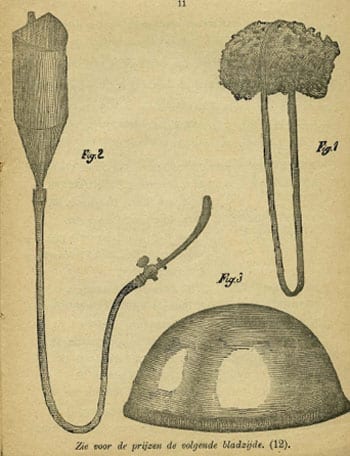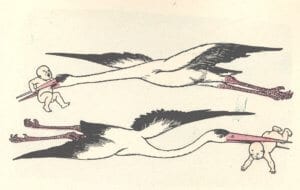Olga Loeber
Nijmegen, Netherlands
Introduction

voorkoming van groote gezinnen
The Netherlands is thought of as a progressive society compared to other countries, but this is actually a recent development.
In 1885, the Neo Malthusian League (NMB) published a brochure titled: “Means to prevent large families.” Founded in 1881, NMB stated that there would be: “no improvement of the race without restricting the population.” This “racial improvement” did not target ethnic background, but rather the poorest of society. During this same period, the Dutch government was concerned with the “moral degeneration” of Dutch society. In 1911 it established the Moral Law, which prohibited the sale of all methods of contraception. “The pill,” introduced in 1961, was prohibited until 1969 except in medical necessity or for families with more than twelve children. Abortion was illegal until 1981, homosexuality was punishable until 1971, and brothels and the distribution of pornographic material were prohibited until 1986. Interestingly, even without access to contraception or abortion, much of the population did limit their family size. The mean number of children in each family at the time was 4.5, in Roman Catholic families 6.5.1
These developments are reflected in the narrative of Jan, born in 1915 and 101 years old at the time of the following interview.
Narrative of Jan, recorded 17th of October 2017
(1925–1935)
“I was born in a family with four boys. One day, we found a booklet in our house with pictures of condoms and sponges and round things.1 But we had no clue what they were used for.
Even though we didn’t know what it was exactly, we knew if our mother found out we had the booklet that we’d be in trouble. We’d be grounded. So, we returned it to its rightful place immediately.
Our parents also had a big glass cylinder in their closet with tubes attached.2 Nothing about this was explained either.
I never had any real sexual education. What I knew, I heard in the neighborhood from other boys. The sisters of some of the neighborhood boys started their periods, and the boys gossiped about it. They said their sisters would bleed, and they’d be given a strap to use. Their mothers would have to wash it separately and hang it to dry.
When I asked my mom about it, she said, “That’s not your business. Those are women’s affairs.”
I had no idea where babies came from. When I was eight, my little brother was born, but I didn’t even know my mom was pregnant.
Later, when I was still young, a girl was born next door. I asked my mom where the neighbour’s daughter came from.

Archive, by Lothar Meggendorfer.
“She was brought to them,” she said.
“Oh,” I said. “How?”
“By the stork,” she said. “I will tell you more later.”
But she never did.
In the neighbourhood, I heard, “You have a dick and girls have a slit and you push your pecker in her slit. That’s what makes babies.” It made no sense to me!
In high school, we were taught about flowers and bees and pollen and pestle. One of the guys in my class asked the teacher whether the process was the same with humans.
“No,” said the teacher. “That’s different, but I am not allowed to talk to you about that. That’s your parents’ job.”
(1940–1960)
“When I was 27, I got married. My girlfriend’s dad had given her a book called The Sexual Life of Man by Heijermans.
After I read the book, a whole new world opened up to me. Before that, I could not imagine things like foreplay. In the movies, you see two people get into bed and they just start having sex right away.3
During the war, I was sent to Berlin for “Arbeitseinsatz” (forced labour). I was given two weeks off to come home and get married. In Berlin, it was easy to get condoms (called Überzieher). So, I brought a few with me.
Later, you could buy condoms in the Netherlands as well. But you could only buy them under the counter in a shop for medical appliances, and they were scarce.
So, when the war was over, I took a stock home with me. After they were gone, I avoided going into those kinds of shops. A friend told me they were sold in a building on the Heemraadsingel at the department of family planning. You could buy condoms there from the receptionist.
The NVSH (Dutch Association of Sexual Reform), founded in 1946 had a whole building there, opened in 1935, called “Consultation Office for Marriage and Sex Life,” first of the NMB, later of the NVSH. I asked the receptionist which other activities they did. He told me MDs were giving sexual education because there was a great lack of knowledge and a lot of nonsense still was going around. I asked my wife whether she wanted to go.
“I don’t,” she said. “Don’t you know enough?”
I said, “What if there’s more?”
“Oh no, Jan,” she said. ”It is all porn.”

In 1947, I volunteered for the NVSH to manage the library because I supported their ideas. First, that sex can be enjoyable and also that there should not be too many children. My wife was at the reception desk and sold condoms and things like that. The clients did not go to the MDs for birth control, but only when there were problems. They would go when they were afraid they contracted a venereal disease or because they did not get pregnant. Then it became clear that “going to bed together” actually meant they went there only to sleep. People sometimes had been married for years without ever seeing each other naked. The nurses gave information about the different methods of contraception: condoms, diaphragms and periodic abstinence. Unwanted pregnancies, abortion, or sterilization were never discussed, not even when there were enough children.
We bought books for the library. Educational books and fiction, too, like The Love of Bob and Daphne and Lady’s Chatterley’s Lover. In our time, it was very weird when you walked around in your naked ass and put flowers in your pubic hair, as described in this book. Everybody still had full pubic hair. So long, one could braid it sometimes. Those books were lent for a dime a week. Aside from group education about sex and the myths around it, information was given about childcare and education. The first periodical we had was “Sensible Parenthood” and later “Sextant.”
I did not really read it, because it was always the same. I only read the letters in the column “We Want to Know” and the cartoons were very funny.
My wife gave comprehensive education to our children. In those days, (around 1960) a lot of misinformation still existed. My daughter came home crying because girls from her class called her names because she had claimed that the stork didn’t bring children.”
Here ends Jan’s story.
Epilogue
In 1961, oral contraception was introduced in the Netherlands and was soon immensely popular. At the time, the Netherlands had the largest family size in Europe and the government feared overpopulation. The attitude towards sexual health changed fundamentally, and around the same time the sexual revolution also took place. Attention was given to the sexual rights of the woman, to abortion, to rape within marriage, and to homo-emancipation.
Until shortly before that, birth control had been a taboo topic. When in 1949 the Dutch Journal of Medicine printed two articles by female doctors, 180 MDs cancelled their subscription.2,3,4 With the introduction of the pill, birth control was transferred into the hands of medical providers, usually the general practitioner.
In 1969 the Dr. J. Rutgers Foundation was founded as an independent medical organization to prescribe birth control and focus on other aspects of sexual health. The NVSH, as “mother organization,” continued as a progressive thinktank.
As late as 1975, many physicians still did not prescribe the pill, certainly not to adolescents or unmarried women. People were worried about possible medical side effects, and every six months all women had to undergo a full physical and gynecological examination.
In reviewing the change in laws and attitudes towards sexuality in the Netherlands, some issues stand out:
- The government tries to steer sexual health based on moral and political grounds and makes a legal basis to regulate this. Afterwards, it takes a very long time before these laws are adapted to the public’s changing views.
- People in the general population do not concern themselves with these laws and find their own solutions.
- Medical providers took the responsibility for birth control only after 1960, and at the same time disparaged nonmedical methods as old-fashioned and unreliable.
Maybe superfluously, the mainstream ideas of the general population change much slower than those of a small liberal forefront, as is shown in the tenacious tradition of the stork.
Endnotes
- Diaphragms
- For douching with a vinegar solution, an old method of contraception
- The sexual education given by parents to their children consisted mostly of warnings about the dangers of masturbation and advice of constraint until marriage. The educational books were similar, with only a few exceptions such as the book by L. Heijermans, (1937), which was rather progressive. Homosexuality, abortion, pornography, and sexual violence were never discussed. A woman was expected to enter marriage as a blank page and cultivated to sexual blossoming by her husband.
References
- Somers A., van Poppel F. Het vergaan der huwelijkskuisheid. De invloed van priesters op de geboorteregeling onder katholieken in Nederland in de periode 1935-1970. Accessed December 15, 2017, https://www.nidi.nl/shared/content/output/2003/mm-78-04-somers.pdf
- Wijnberg R. Voorbehoedmiddelen tegen zwangerschap. Ned. Tijdschr v Geneeskd; 1949;93:4242-5
- Scheltema-Joustra A. Geboorteregeling in Nederland en enige andere Europese landen. Ned. Tijdschr v Geneeskd; 1949;93:4263-9
OLGA LOEBER, MD, has worked as a general practitioner and later in sexual health for about forty years. She was in service of a NGO (for the Rutgers Foundation) since 1974 and later in a private practice in Arnhem, the Netherlands. She is interested in cultural and antropological aspects of sexual health, such as virginity, the background of repeat abortion, and sexuality education. She has published in the Journal of the European Society for contraception and sexual health.

Leave a Reply